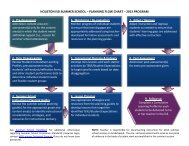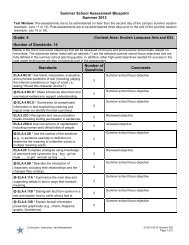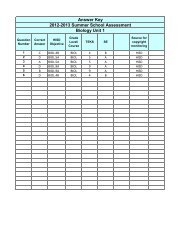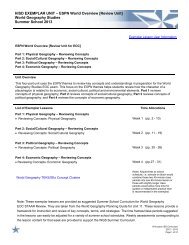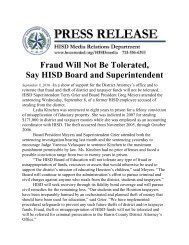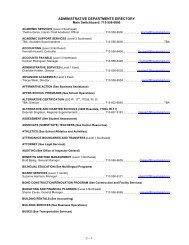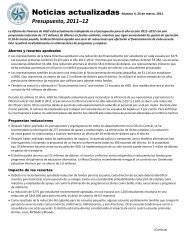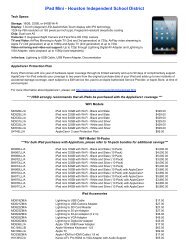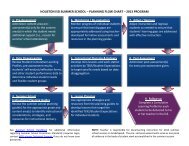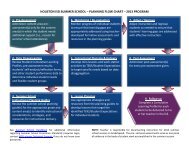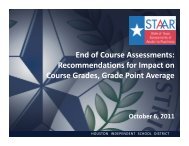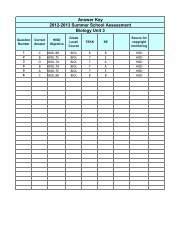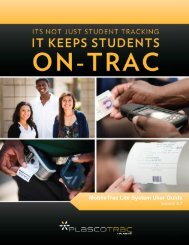Instructional ConsiderationsHISD PLANNING GUIDEEnglish Language Arts Grade 8SUMMER SCHOOLAllow students to use an interactive website to review the elements of short story. The Annenberg Media- Literaturewebsite allows students to control the information of short stories as a method to review the elements of plot. SeeResources for Annenberg Media- Literature Interactive website.Model annotating a text for specific elements (plot, setting, similes, and metaphors). Using sticky notes to annotate atext serves as a means for teachers to monitor student comprehension and note where difficulties occurred. See ELABest Practices MS in Resources. (ELA.8.Fig19C)Formative Assessment- Exit Slips are a way to determine which students understand a concept in reading and whichrequire more instruction. By assessing the responses on Exit Slips, instruction can be adjusted to accommodatestudents’ needs for the next class period. See Formative Assessment: 3-2-1 Slips in Assessment Connections.Hold an informal whole class discussion on characters. Ask students to think about the effects of characters on a textand audience. Have students respond to the following questions: Where do authors get ideas for their characters? Why are characters important to a story? What are some of your favorite characters and why? If you were to create a character, what would your character represent and why?A Reader’s Workshop on character and point of view can be found in Literature Grade 8 in Resources.Develop further questions to guide students to an understanding that characters are often representative of a specifictime period and can offer a commentary on a cultural or historical event, issue, tradition, or value. Students need tounderstand that authors create characters to affect and connect to their audience. For a Reader’s Workshop onhistorical and cultural contexts, see Literature Grade 8 in Resources. For a mini-lesson that integrates cultural contextsin a reading selections, see Resource Manager Grade 8, <strong>Unit</strong> 7 in Resources. (ELA.8.3C)Encourage students to analyze characters in cooperative groups. Students can practice describing a character byplaying the Name that Character Game. Students are given passages from a text and asked to match the passage withdescription words based on a character described in the text. See Resources for Name that Character Game.Students can work together to deeply analyze a character and his/her personality through his/her actions, thoughts, andspeech. See Instructional Strategies for Laying the Foundation: A Resource and <strong>Planning</strong> <strong>Guide</strong> and Laying theFoundation Style Analysis: Linking Characterization to Meaning lessons, such as Post-Mortem of a Protagonist,Character Analysis- Edna’s Ruthie, and Character and Relationships- Ender’s Game. (ELA.8.Fig19D)Use a media clip to understand characterization in film. See Media Smart DVD-ROM Media Study: Understandingcharacterization in Film: Whale Rider in Resources. (ELA.8.Fig19F)Instructional Accommodations for Diverse Learners ELLs need the opportunity to practice using new language, expressions, and academic vocabularylearned during instruction. Provide Oral Scaffolding for students to do this through the use of sentencesstems such as:• I heard the new word/phrase…• One new phrase I used was…See Navigating the ELPS in the English Language Arts and Read Classroom in Resources. (ELPS C.2c)Remind students that the actions of characters often lead the audience to an understanding of the theme of a story.Readers can learn about the world around them by experiencing the conflicts and resolutions in a work of fiction. Thisunderstanding begins with the ability to analyze characters by making inferences about their thoughts, actions, speech,etc. See Instructional Strategies for an Attribute Web and Character Map.To assist students in further analyzing theme, have students answer probing questions. Questions may include: What happened to the main characters? What do they learn from their experience? What do you learn about people, values, or society from this story? - English Language Proficiency Standards (ELPS) - Literacy Leads the Way Best Practices - Aligned to Upcoming State Readiness Standard- State Process Standard R - State Readiness Standard S - State Supporting Standard© Houston ISD Curriculum2013 – 2014Page 5 of 10
Instructional ConsiderationsHISD PLANNING GUIDEEnglish Language Arts Grade 8SUMMER SCHOOL What hints does the title give you about the author’s possible message? What is the main message, or theme, of this story? Do you agree with the theme or message expressed in the story? Why or why not? Is the theme a realistic observation about human nature, or does it seem too optimistic, too negative, or toonarrow-minded?See Best Practices Toolkit in Resources for theme analysis frames.Have students compare and contrast the short stories read. Begin by comparing characters from the short stories. Asstudents become comfortable, move them to comparing the themes or points of view of the stories and commenting onthe effects of each on the story or audience. See Venn Diagram in Instructional Strategies. (ELA.8.3A)Instructional Accommodations for Diverse Learners For ELLs, have students compare and contrast cultures to build background knowledge and createconnections to a text. See Culture Comparison in Instructional Strategies.As a pre-assessment for writing, have students create a RAFT writing piece (a letter). This is an informal writing piece tomeasure the students’ preliminary strengths and areas of difficulties. See Instructional Strategies for RAFT.WritingInstructional Accommodations for Diverse Learners In considering a RAFT, teach sequence words needed by ELLs to make the order of events clear:yesterday, last week, first, second, third, at that point, soon, next, after that, then, and finally.PrerequisitesStudents should have prior knowledge of sentence construction.Background Knowledge for TeacherReading and writing are not separate elements of Language Arts and should be integrated throughout the unit.To assist students in learning to correctly punctuate dialogue, use comic strips. Allow students to create new dialoguefor the characters of the Peanuts comic strip. See Resources for Comic.com website and Dialogue Tags. (ELA.8.20B.ii)Review capitalization and various forms of punctuation through mini-lessons in Writer’s Notebook. (ELA.8.20A,ELA.8.20B.i)Instructional Accommodations for Diverse Learners ELLs need to learn the relationship between sounds and letters in the English language to assist intheir writing. Allow them to practice through Homophone/Homograph Sorts. The teacher prepareshomophone/homograph cards, listing words that sound the same, but are spelled differently such as:know/no, hear/here. The teacher asks the students to group the words that sound the same together andthen explain the meanings of each. See Navigating the ELPS in the English Language Arts and ReadClassroom in Resources. (ELPS C.5a)A student receiving special education services may receive instructional and assessment accommodations. TheARD/IEP committee must document instructional and assessment accommodations in the student’s IEP. TheTexas Student Assessment Accommodations information is located on the Texas Education Agency website. - English Language Proficiency Standards (ELPS) - Literacy Leads the Way Best Practices - Aligned to Upcoming State Readiness Standard- State Process Standard R - State Readiness Standard S - State Supporting Standard© Houston ISD Curriculum2013 – 2014Page 6 of 10




